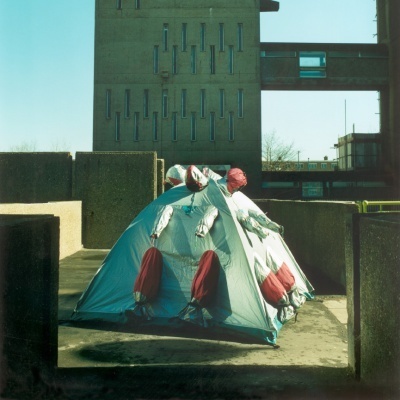Refuge wear
Lucy Orta ’Refuge Wear’
project description
‘’Refuge Wear (1992-98), are temporary shelters and architectures that can be transformed into clothing to offer protection from harsh conditions and shelter in emergency situations. The series, which Lucy Orta began working on during a period of economic recession provoked by the Gulf War and subsequent stock market crash, combines a dual response to this unprecedented global crisis. They are poetic responses to the humanitarian aid appeals for shelter and clothing to help the Kurd refugees fleeing the war zones, and to the increasing numbers of homeless people on the streets of Paris.
Refuge Wear are portable habitats that convert into anoraks and backpacks, designed for personal comfort and mobility for nomadic populations. The transformation from shelter to clothing and vice versa is fundamental to the concept of freedom of movement, free will or choice, new relationships and new cultural exchanges, the homo mobilis. They incorporate arm and hood appendages, or pockets that contain both functional and symbolic objects. Their ergonomic forms allow for a minimum vital body space and they employ cutting-edge design innovations such as telescopic carbon armatures that raise the fabric above the chest to eliminate the effects of claustrophobia. The materials contain technical properties such as microporous Rip Stop with or PU coatings, metaphors for body comfort and protection.
Throughout the 1990's Lucy + Jorge Orta staged public interventions to challenge acts of social disappearance and to render the invisible populations, visible once more. Peripheral urban spaces such as squats, railway stations, housing projects, bridges and subways were chosen as arenas for simultaneous happenings. These interventions –warnings, alarm bells– signal out social issues that the media were ignoring at that time. The interventions staged in London’s East End were commissioned by Dazed and Confused and photographed by John Akehurst.’’
https://www.studio-orta.com/en/artwork/86/Refuge-Wear-Intervention-London-East-End-1998
review
The reason this is a great social art and design project is because it’s a social problem which still has a great influence in modern society. It's a timeless design and product that still could be used today as well. A few designs are multifunctional in different situations. Some pieces of the project can afford protection, mobility, a certain comfort and shelter. Others are used to bring a certain message. It is on one hand very abstract but on the other hand quite functional. The entire artwork is connected through one thing: survival. The project puts a spotlight on the normally unseen or ignored people. It gives people a new perspective on the lifes on the street and the current social issue: the refugees and the homeless. It offers a helping hand while giving them a voice and platform.
Based on the cultural transitions, REFUGE WEAR goes strong. It’s meant to start a dialog, to provoke discussion. Artworks like this are the ones that bring awareness to people. Maybe it takes time, but it brings a change in our community. Some will consider it to be confronting and provoking, which is exactly the goal of this project.
The project is also a good example focused on the living world of citizens. This is because of the fact that she provides a platform for those who aren’t heard or seen, for people who have been ignored or seen as inferior.
improvements
In my eyes one of the points for improvement is the fact that some works of art in this collection are sometimes too abstract. At first sight you cannot see what is being said about what subject, what will cause people to lose interest. So you are missing out on a lot of people and visions. There can also be made real use of the functional pieces from the collection.
